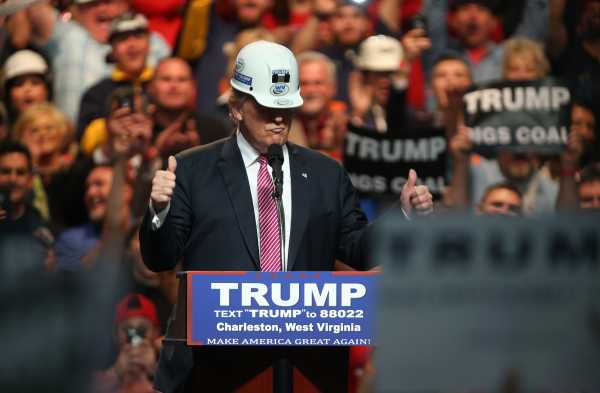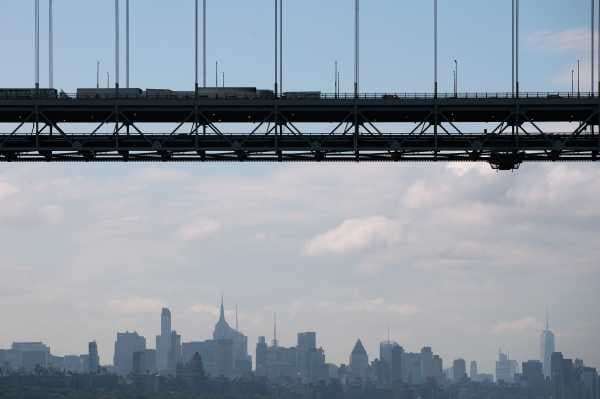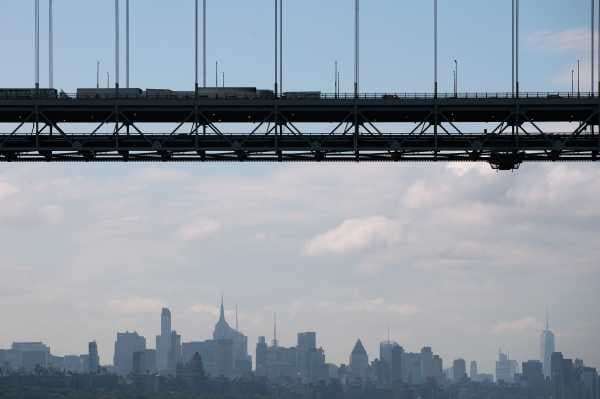
It’s always infrastructure week in President Donald Trump’s White House. So when Trump threatened to shut down the government over an infrastructure project in his home state, it threw Congress for a loop.
Trump’s refusal to sign a spending bill with funding for the Gateway project, a $30 billion commuter rail, bridge, and tunnel proposal connecting New York and New Jersey under the Hudson River — which advocates call one of the nation’s most “critical infrastructure” projects — was one of the major hang-ups in Congress’s last-minute negotiations over government spending this week.
Trump, who has promised to fix the country’s “crumbling” bridges and roads with “the biggest and boldest infrastructure investment in American history,” has repeatedly and systematically undermined Gateway’s urgency. Why? Republican lawmakers suspect it’s because of an ongoing feud with Senate Minority Leader Chuck Schumer, one of the project’s fiercest advocates.
Now, as lawmakers scramble to pass a spending bill to keep the government open past March 23, they’ve had to leave out the bipartisan $900 million infrastructure spending proposal for Gateway. Instead, the spending bill will include as much as $446 million through Amtrak, and more in federal grants that do not require the Department of Transportation’s stamp of approval, that can go toward Gateway.
According to reporting from Bloomberg, Amtrak estimates it will be able to contribute $388 million to building Gateway. Republicans are telling Trump that he now has more control over the funding.
Infrastructure has long been hailed as a policy area ripe for bipartisan legislating. But Trump has made it clear his big talk on infrastructure might be just that.
What is the Gateway Project?
In the past year, commuting between New York and New Jersey has fraught with delays, accidents, and track closures. Only last week, the Portal Bridge, an Amtrak-operated rail bridge connecting Newark, New Jersey, and Jersey City, was stuck in the open position for hours, delaying hundreds of morning commuters.
“Pretty frustrated, I’ve been doing this for 30 some-odd years, this is the worst it’s ever been, absolutely the worst, no question,” commuter Dave Gialinilla told the local ABC station after the delay.
Put simply, the infrastructure is old and crumbling. The tunnels under the Hudson River were built more than 100 years ago, and engineers estimate they will fail within the next decade — a deterioration that was only amplified by Hurricane Sandy. As Gateway advocates are quick to tell you, these railways carry more than 800,000 riders per day — the most heavily used passenger rail line in the country — and serve a region that makes up 17 percent of the country’s population and produces $3 trillion in economic output, or 20 percent of the national gross domestic product.
In other words, the stakes are high.
“The Gateway Tunnel is vital to our New York economy, [and] is vital to the whole Northeast,” Schumer has said. “The tunnels that now go under the Hudson are old … and Sandy was the final blow. If they collapse, if they are not used, if they fail, we will go into a recession immediately. No one will get across the Hudson.’’
The Gateway Program, whose cost has ballooned over the years to $30 billion, is a series of commuter rail and tunnel projects aimed to improve and expand transportation infrastructure between the two states. The main project is a $12.7 billion rail tunnel between Manhattan and New Jersey under the Hudson.
Under the Obama administration, New Jersey and New York state struck a deal with the Department of Transportation that the states would pool resources to cover half the cost if the federal government fronted the other half. Late last year, the states put up a total of $5.55 billion toward the tunnel project, which with federal dollars would make $11.1 billion, slightly shy of the initiative’s total cost.
In Congress, a bipartisan group of New York and New Jersey lawmakers proposed putting $900 million toward Gateway to jump-start the project. But then Trump got involved. He didn’t want this project to get funding.
Trump is reportedly mad at Schumer and tried to tank this whole thing



Trump loves talking infrastructure. He’s from New York. He even gave a full-throated endorsement of earmarks, money that lawmakers pile on to already moving legislation for special projects in their districts, a practice conservative lawmakers banned. Gateway almost seems like a project tailor-made for Trump to get involved with.
And at the start of Trump’s administration, it was considered to be a prime area for bipartisan compromise.
But by the end of last year, it became clear Trump wasn’t going to play nice with the New York and New Jersey Democrats — a move that doesn’t really add up for a president who has championed rebuilding the nation’s roads and bridges.
“It doesn’t make sense to anybody,” Carlo Scissura, director of the New York Building Congress, one of the main groups advocating for the Gateway project, said. “It is actually a terrible slap in the face to a region that makes 10 percent of the nation’s GDP. Pulling this money out really just says screw you to New York.”
In early March, Transportation Secretary Elaine Chao came out against using federal funding for the project, and Trump’s administration dropped the deal New York and New Jersey had made under the Obama administration. Chao said the states should put up more money for Gateway instead of getting government loans.
Then she said the move to cancel the federal government’s commitments to Gateway came from Trump himself, raising speculation that it was because of a personal feud with Schumer, whose long relationship with Trump has soured over politics. Trump’s budget proposal to Congress earlier this year even cut transit and Amtrak funding.
Rep. Leonard Lance (R-NJ) attributed Trump’s reversal on the Gateway project to a “dispute” between Schumer and Trump over the president’s administrative appointments.
“I think Sen. Schumer should move on some of the appointments the president has made to fill his own administration,” Lance told reporters.
New York and New Jersey Republicans haven’t always been on Trump’s side on policy either; several voted against both the Obamacare repeal effort and the GOP tax law, which adversely impacted blue states. Even so, Republicans don’t think they are the problem — and spent the past weeks pushing Trump to see the urgency of the project.
“If the news reports are accurate that he wants to kill it or hold it because he’s mad at Chuck Schumer, that makes no sense,” Rep. Peter King (R-NY) said. “This is essential to the national economy as well as the regional economy.”
Trump didn’t budge, and Republican leaders, who were less than eager to pick a fight with the president over government spending, had to find a workaround.
Congress has found a way to give Gateway funding and convince Trump they didn’t
Lawmakers released a $1.3 trillion spending bill this week that didn’t include the $900 million funding proposal for Gateway — by name, anyway.
The compromise didn’t leave Gateway completely dry. Instead, it put an additional $446 million toward Amtrak and more in other infrastructure grants, some of which don’t need the administration’s stamp of approval to be put toward Gateway.
The spending bill was essentially designed to make sure Trump didn’t throw a fit.
“This funds the wall, fixes the military, fights opioids, does the things that we said and does not fund Gateway — gives Donald Trump the decision on Gateway,” House Speaker Paul Ryan said on Fox & Friends Thursday morning, hinting at how Republicans sold the final spending bill to Trump.
Of course, this final compromise is far from the original ask, and Amtrak likely won’t use all of the additional funds toward Gateway alone. Advocates for the Gateway project say the compromise could draw out construction and increase the overall cost of the project.
In all, the Trump administration’s position on Gateway has become somewhat of an avatar for the president’s ephemeral efforts to push infrastructure. The White House has declared “infrastructure week” so many times without any actual movement that the notion has become a running joke among lawmakers and congressional aides.
Sourse: vox.com






